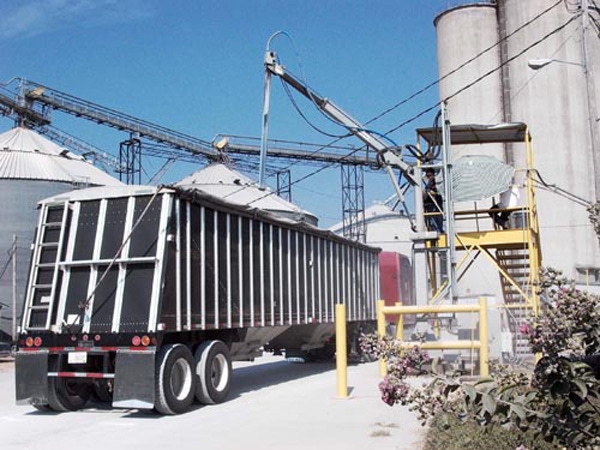June 7, 2016

Some American wheat farmers are not only going to lose money on every bushel they harvest this month, many won’t have a proper place to store it.
U.S. grain silos still hold surpluses from last year. Combined stockpiles for major crops -- corn, soybeans, wheat and sorghum -- are the biggest for this time of year since 1988. With demand slowing and output rising, space will get tighter, especially for wheat, which is the first one harvested. Some growers may dump grain in parking lots or vacant buildings.
“It will be the worst storage crunch in the 30 years I have been trading wheat,” said Michael O’Dea, a risk management consultant at INTL FCStone Inc. in Kansas City, Missouri. “A lot of grain will end up in ground piles.”
While farmers expanded storage in recent years, that’s been undermined by global crop surpluses and a strong dollar. Once the world’s biggest wheat exporter, the U.S. saw its shipments in the year through Tuesday drop to the lowest since 1972. With inventories up 30 percent and expected to swell further, the price outlook is getting more bearish. Chicago futures tumbled for three straight years, and in February touched the lowest level since 2010.
The glut may only get bigger. Global supply, including production and inventories, will exceed consumption by the most ever in the year that ends in June 2017, with the harvest expected to be the second-highest on record, the International Grains Council said May 26.
For many growers, the slump means they are spending more to grow wheat than they can collect when the grain is sold, according to analysts at Societe Generale SA, which forecast Chicago wheat futures will average $4.52 a bushel in the third quarter, compared with $4.8675 now. Kansas State University estimates each bushel costs $3.90 to $5.18 to produce. Moneys managers have been betting prices will fall for almost 10 straight months.
Winter wheat harvested in June and July across the Great Plains is among the first crops to arrive each year at grain elevators, with corn and soybeans collected in September and October. While there isn’t any co-mingling, most silos can be used to store different crops, depending on need. Piling grain on the farm isn’t all that unusual, but without an impervious floor, walls and some kind of covering, there is an increased risk of pest and moisture damage.
But with so much left over from last year, growers from Texas to Nebraska probably will exceed local storage capacity by at least 15 percent, said Troy Presley, a grain merchandiser for Comark Grain Marketing LLC in Cheney, Kansas. The company markets crops for 13 cooperatives with more than 77 locations in Kansas, Oklahoma and Nebraska.
“Storage space is going to be very tough to find this year,” Presley said. “Farmers have sold the smallest amount of wheat for harvest delivery in at least 10 years, compounding the storage crunch.”
Domestic storage capacity for more than a dozen different kinds of grain and oilseed crops has increased 22 percent in the past decade to 24.21 billion bushels, U.S. Department of Agriculture data show. But as of March 1, well before this year’s harvests, stockpiles of wheat, corn, sorghum and soybeans totaled 10.9 billion bushels, up 5.6 percent from a year earlier, according to the USDA.
In Kansas, the biggest producer of winter wheat, inventories were 29 percent bigger than a year earlier, government data show. Even before the harvest, leftover grain is using up 52 percent of the state’s storage capacity, compared with 41 percent a year earlier, according to the USDA.
‘Extra Bushels’
Production of hard red winter wheat, the variety used to make bread, will rise 4.3 percent this year to 863 million bushels, the USDA said May 10. The crop may be even bigger, topping 900 million bushels, because timely rains in April boosted yields and farmers sprayed fungicides to prevent disease, INTL FCStone’s O’Dea said.
“An extra 40 or 50 million bushels is not going to find a home,” he said.
There may be more storage space available outside the Plains, the main growing region, but transporting wheat there adds to the cost. The discount of cash-market grain to futures probably will fall to $1 a bushel, the most since 2010, O’Dea said.
The cost of U.S. wheat at export terminals in New Orleans costs at least 50 cents a bushel more for buyers than grain purchased from Russia, Ukraine and Europe, USDA data show. Wheat is so cheap, domestic livestock producers are considering using it in feed rations along with corn and sorghum.
“Cash prices could become weaker at local elevators as they are reaching their storage capacity limits,” said Dan O’Brien, a Kansas State University agricultural economist in Colby. “It will be a sizable crop."
To contact the reporters on this story: Jeff Wilson in Chicago at [email protected]; Megan Durisin in Chicago at [email protected]
To contact the editors responsible for this story: Simon Casey at [email protected]
Steve Stroth, Millie Munshi
© 2016 Bloomberg L.P
You May Also Like




